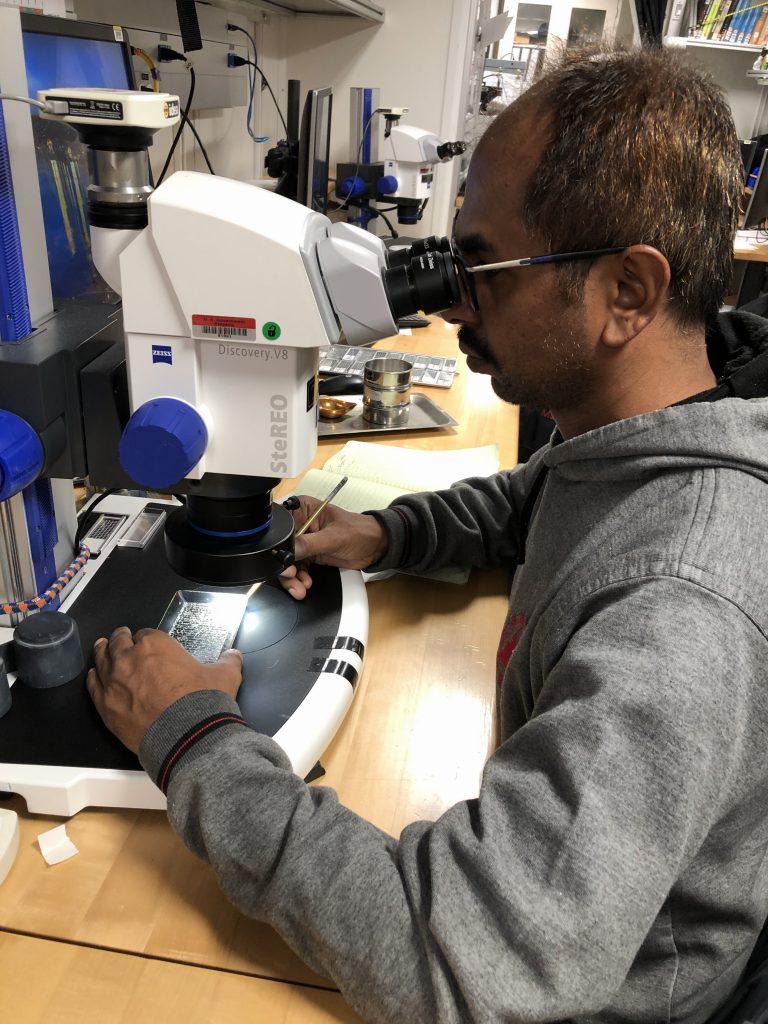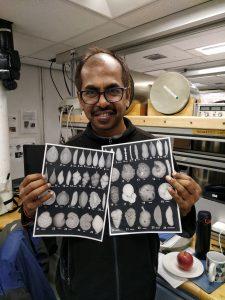
Career Spotlight: Micropaleontologist Raj Singh

Raj Singh Interview
Please describe your job duties while on the JR. What will you be doing on a daily basis?
-
-
-
-
-
-
-
-
- To collect PAL samples from every core. I process the samples and describe the beautiful Foraminifera – single cellular microorganism to know the (a) age of the sediment, (b) environment of deposition, and (c) to understand climatic and oceanographic changes that took place over the years and its global implication.
-
-
-
-
-
-
-
Describe one instrument or tool that is essential for you to do your job? Or a piece of equipment on the JR that is useful and why – what does it do?
-
-
-
-
-
-
-
-
- The stereo-zoom microscope: I can analyze the processed samples under the stereozoom microscope and a table top Scanning Electron Microscope – to get high resolution images of the foraminifera test.
-
-
-
-
-
-
-
Why is your work (or research) important? What question are you trying to answer or how does your work/research help assist/advance scientific knowledge?
- The oceanographic and climatic instrumental record is available for just the last 120 years, which is not enough history to understand the natural factors forcing climate change. The paleoclimatic research provides in-depth knowledge about the factors that affected past climate changes. I am here to answer the following two questions beyond our prime expedition objectives. 1) To find out the role of the Southern Ocean in global climate variability, especially the Asian Monsoon systems during the Late Miocene to Early Pleistocene. and 2) To do a comparison of benthic foraminifera of the higher latitudes regions of the other oceans and the Southern region of the Pacific Ocean for understanding role of Antarctic Circumpolar current.

Why the ocean? What made you choose a career at sea or career that involves the ocean?
- There are number of proxies available to understand paleoclimatic changes that are preserved in various marine and terrestrial natural archives. I am using the foraminifera proxy to understand paleoclimatic changes, which generally dwells in sea and ocean. Foraminifera is a single cellular microorganism that lives in marine to brackish water conditions and their test (outer layer) have unimaginable variations. They are excellent indicator to trace paleoceanographic and paleoclimatic changes. I was introduced to this marine microorganism in the year 2000 AD by Prof. M.S. Srinivasan and I have been fascinated with them ever since. Later my Ph.D. supervisor Prof. Anil K. Gupta motivated, guided and helped me choose as career. The ocean floor is natural archive of this microorganism, hence my career involve ocean.
What are you most excited about for this expedition and/or being on the JR?
- To get the core age dates all the way back to Miocene time period and have very well-preserved carbonates.
What are three things you think are needed for a successful expedition at sea? And Why!
- Co-operation from fellow scientists, because you have to live with everyone
- Help of Co-chiefs, technicians, and staff of the JR, because you are dependent on them for various activities related to the expedition
- Support of your own family back home. This able you to work peacefully without any worries.
If you could answer one question about our Earth – what would it be and why?
- Never thought off…Maybe the movement of different plates, which cause construction of different mountains to oceans at different time period and causes severe earth quakes/tsunamies. I wonder, if I may predict actual timing and place of an earthquake.
What is your favorite sea creature and why?
- For me, foraminifera. They are just beautiful, clever, and adapted to different changing environments over the years. They are surviving on Earth since last ~ 540 million years!

When did you know you wanted to pursue a career in science or an ocean science career?
- After my high school, I realize that I cannot memorize phrases, I was poor in literature, and science excited me. Every time a new expectation. It start with one goal and ended with something new, which may not be part of original research plan.
What do you personally hope to gain or experience while on EXP383?
- Besides excellent science and good samples, lots of good memories, friends from across the globe. The experience of working in cold high latitude Southern Pacific Ocean with many renowned and new scientists as a team.
What message do you have for anyone considering a career at sea or a career involving the ocean sciences?
- Almost 70% of the Earth is ocean, which impacts our daily life. For my country India, monsoon is back bone of agrarian economy. The formation of monsoon to disastrous cyclone is associated with ocean. It is very much important to assess land, ocean, and atmospheric interactions processes to understand the genesis and path of cyclone and monsoon and its long term forecast for society. During a 1999 cyclone of Odisha state India, nearly 20,000 peoples lost their lives while during recent cyclone ‘Fani’ (3/5/2019) of almost same intensity, the government manage to save human life by evacuating 1.2 million people to safer places. This was possible, due to accurate forecast of the cyclone path and timing of land fall.
What do you do back home when not on the JR?
- I am a university professor so I am often busy working with students. But most importantly, I will enjoy visiting my parents, and spending quality time with family.
Do you get seasick? If yes or sometimes, please also select the other tab and describe how you cope with it.
- Sometimes: In the beginning of an expedition, I feel like seasick. I used to lie down in lower tween deck for some time and consume fruits (green apples) for a couple of meals.
The need for space comes in many forms. Which type of space, in general, is the most important to you?
- _x_Personal Space
- ___Creative Space
- ___Outdoor Space
- ___Emotional Space
- ___Physical Space
- ___Spiritual or Meditative
- ___Outer Space
- ___Community Space
- ___Quite Space
- ___Productive/Work Space
- ___Digital/Virtual Space
- ___Public Space
- ___Inner Space
- ___Other:
Why that type of space? What makes it important to you and will it be available while on the JR?
- The personal space, where I like to spend 15-20 minutes on meditation every morning. This gives me energy and strength for the entire day. This also makes it possible to analyze the previous day and set targets for the entire day. Yes, it is available on JR.